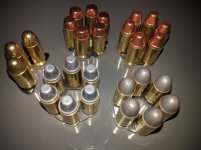A dear friend of mine has a 625 PC revolver and is using his Dillon 550b with RCBS dies...The problem that he is having is that no matter what bullet/ casing/ amount of crimp used after firing 5 rounds the 6th round has up to 30-40 thousandths forward travel.
Not enough to lock up the cylinder but still enough to change things.
Now when I reload .45 acp on MY 550 with Dillon dies, no matter what bullet/casing/amount of crimp used I don't have this as an issue.
The only constant in his set up verses mine is the die....
Can anyone shed some light on why this is happening. Do you think that the REAL problem is in his RCBS carbide dies?
We are shooting in an Action Pistol match this weekend and I am going to loan Jesse my dies and shellplate to see if the problem goes away.
I am baffled and am turning to the forum for fresh ideas.
Randy
PS. He has been trying different amounts of crimp with lead/plated/coated/FMJ bullets as he is experiencing severe leading after 12 rounds. I think that a call to Smith is in order....What do you all think?
Not enough to lock up the cylinder but still enough to change things.
Now when I reload .45 acp on MY 550 with Dillon dies, no matter what bullet/casing/amount of crimp used I don't have this as an issue.
The only constant in his set up verses mine is the die....
Can anyone shed some light on why this is happening. Do you think that the REAL problem is in his RCBS carbide dies?
We are shooting in an Action Pistol match this weekend and I am going to loan Jesse my dies and shellplate to see if the problem goes away.
I am baffled and am turning to the forum for fresh ideas.
Randy
PS. He has been trying different amounts of crimp with lead/plated/coated/FMJ bullets as he is experiencing severe leading after 12 rounds. I think that a call to Smith is in order....What do you all think?

